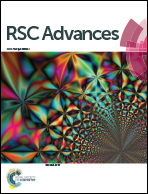The antioxidant mechanism of nitroxide TEMPO: scavenging with glutathionyl radicals†
Abstract
A rhodamine-nitroxide probe (R-NO˙), combining rhodamine fluorophore with a 2,2,6,6-tetramethylpiperidinyl-1-oxy (TEMPO) receptor unit was introduced to probe glutathionyl radicals (GS˙) with high sensitivity and selectivity. The R-NO˙ probe could effectively scavenge GS˙ radicals with fluorescence enhancement since the nitroxide group restored the fluorescence properties. In this work, horseradish peroxidase (HRP)-catalyzed and metal-catalyzed oxidation systems were selected as the model of simulating the generation of GS˙, and we found that the metal-catalyzed system had the same experimental results with the HRP-catalyzed system, which provided a new approach to demonstrate the strong oxidant ability of the hydroxyl radical (˙OH) to initiate toxic GS˙. Furthermore, we confirmed that the production of GS˙ abided by a radical-initiated peroxidation mechanism of GSH with the mass spectrometry (MS) analysis and fluorescence spectroscopy. By using combined high-performance liquid chromatography (HPLC) detection and MS analysis, we also demonstrated that the R-NO˙ was converted into fluorescent secondary amine derivative (R-NH). The application of the probe in biological system was explored to monitor GS˙ in HL-60 cells and secondary amine fluorescence was observed upon stimulation by hydrogen peroxide and phenol. Development of fluorescence was prevented via preincubation with the thiol-blocking reagent N-ethylmaleimide (NEM).


 Please wait while we load your content...
Please wait while we load your content...